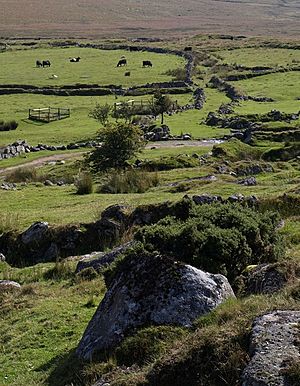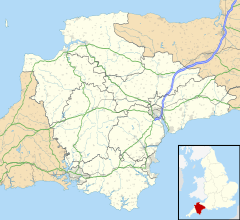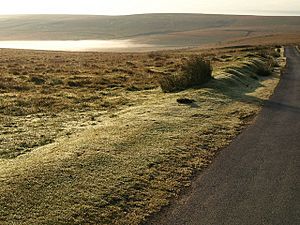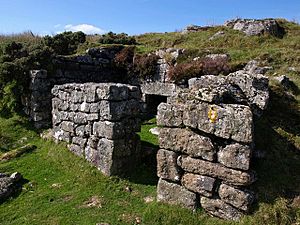Whiteworks facts for kids
Quick facts for kids Whiteworks |
|
|---|---|
 Remains of tin mining at Whiteworks |
|
| OS grid reference | SX 612710 |
| Shire county | |
| Region | |
| Country | England |
| Sovereign state | United Kingdom |
| Post town | PRINCETOWN |
| Postcode district | PL20 |
| Police | Devon and Cornwall |
| Fire | Devon and Somerset |
| Ambulance | South Western |
| EU Parliament | South West England |
Whiteworks (also called White Works) is a small, old mining village. It is located near Princetown in Dartmoor National Park, Devon, England.
For a long time, tin mining was the most important activity here. Whiteworks was once home to one of Dartmoor's biggest tin mines. The first houses and the people who lived in them were all connected to this mining work. Later, in the 1900s, the area was used more for farming. Today, most of Whiteworks is empty, but it is still a popular spot for people who enjoy walking. The famous Abbots Way Walk passes close by.
Contents
Where is Whiteworks?
Whiteworks is in an open, wild area of Dartmoor. It is about 3 kilometers (2 miles) south-east of Princetown. From Whiteworks, you can see the Fox Tor Mires, which are very wet and can be dangerous. A tricky path goes across these wet lands to Fox Tor, which is about 1.5 kilometers (1 mile) south-east of the village.
You can reach Whiteworks by car using a narrow road. This road branches off from the B3212 road in Princetown. It was first built by Sir Thomas Tyrwhitt to reach his property called Tor Royal.
Why is it called Whiteworks?
The rocks at Whiteworks are made of granite. Over time, the granite here has changed. A mineral called feldspar in the granite has broken down. It turned into a white clay called kaolin.
Because of this, the tin ore found here was white. This white tin ore gave the place its name: 'White Works'.
Special Plants
The Whiteworks area is home to a few special kinds of moss. One type is called Polytrichum urnigerum, which grows in streams. Another is Bryum turbinatum.
History of Whiteworks
Early Mining Days
People have been mining tin at Whiteworks for a very long time. Records show that tin was being dug up here as early as 1180. This was during the Middle Ages.
More serious mining started around 1790. This was when the Industrial Revolution began. Factories needed a lot of tin, and new machines made it easier to mine. Before this, it was too hard to mine deep in Dartmoor.
At first, there were no places in Devon to melt the tin ore. So, the tin from Whiteworks was sent to a place called Calenick Smelting House. This was near the town of Truro in Cornwall.
Mining in the 1800s
Mining continued on and off during the 1800s. Workers also tried to drain the Fox Tor Mire to make it safer. For some time, Whiteworks was one of the biggest tin mines on Dartmoor. Other large mines were Eylesbarrow and Gobbet.
For example, in the early 1870s, the mine produced about 8 to 9 tons of tin ore each year. At this time, a mining businessman named Moses Bawden owned the mine. He was from Tavistock.
The End of Mining
By the 1880s, the mine was no longer being used. But at the start of the 1900s, the price of tin went up. So, mining started again for a short time. However, all mining at Whiteworks stopped completely in 1914. In its last years, the mine was owned together with Golden Dagger Mine and Hexworthy Mine.
Around the same time, a new farmhouse was built. After mining stopped, the land around Whiteworks was used more and more for farming. People raised animals like ponies there.
Whiteworks Today
By the 1980s, Whiteworks was mostly empty. Some of the buildings, including the farmhouse, were pulled down by the Dartmoor National Park Authority. A few cottages are still standing. One of them is owned by Plymouth College and is used for outdoor activities.
Other buildings, from the mining and farming days, are now just ruins. You can also see fenced-off old mine shafts. These ruins, along with the beautiful landscape, make Whiteworks a popular place for hikers. Many walks start from Princetown and come through Whiteworks. The yearly Abbots Way Walk, which happens on the first Sunday in October, passes within 500 meters of Whiteworks.




